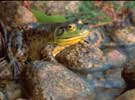Why Wetlands?
 Not land or water, but a fluid combination of both, wetlands are among the most productive habitats on Earth. Wetlands are all built on a simple foundation: water becomes trapped, either through poor drainage, periodic flooding or by coastal barriers such as sandbars, and a wetland -- that unique mix of land and water -- is born. Not land or water, but a fluid combination of both, wetlands are among the most productive habitats on Earth. Wetlands are all built on a simple foundation: water becomes trapped, either through poor drainage, periodic flooding or by coastal barriers such as sandbars, and a wetland -- that unique mix of land and water -- is born.
From this beginning, wetlands develop in a number of ways depending on local climate conditions, the availability of nutrients, and the geography and soils of a site. They also change over time: an open marsh may dry out enough to become a wooded swamp, only to revert back to open marsh again after heavy flooding.
In the past, wetlands were thought of as mosquito-infested wastelands that could only be dealt with by draining, filling or paving. Now, wetlands are increasingly recognized as much more dynamic, productive and diverse ecosystems. They are wildlife nurseries and nesting sites, feeding grounds and resting places, water filters and reservoirs. They help protect shoreline areas from storm damage, control and reduce flooding, clean sediment-laden waters, and attract fish, birds, amphibians, reptiles and mammals. They are also great places for people to explore and reconnect with nature.



Yet, despite these values, wetlands continue to be lost at an alarming rate. They are drained for agriculture, filled for development, polluted by toxic runoff, invaded by exotic species, and damaged by artificial changes in water levels. Today, almost two-thirds of southern Ontario wetlands have been lost or severely degraded, while the health of those that remain continues to be threatened. If we continue to lose wetlands, a large and important piece of the natural system that keeps our world healthy will disappear.
Wetland Functions and Values
Wetland Stresses
Habitat Types and Species Protected
Definitions
Wetlands Home
|